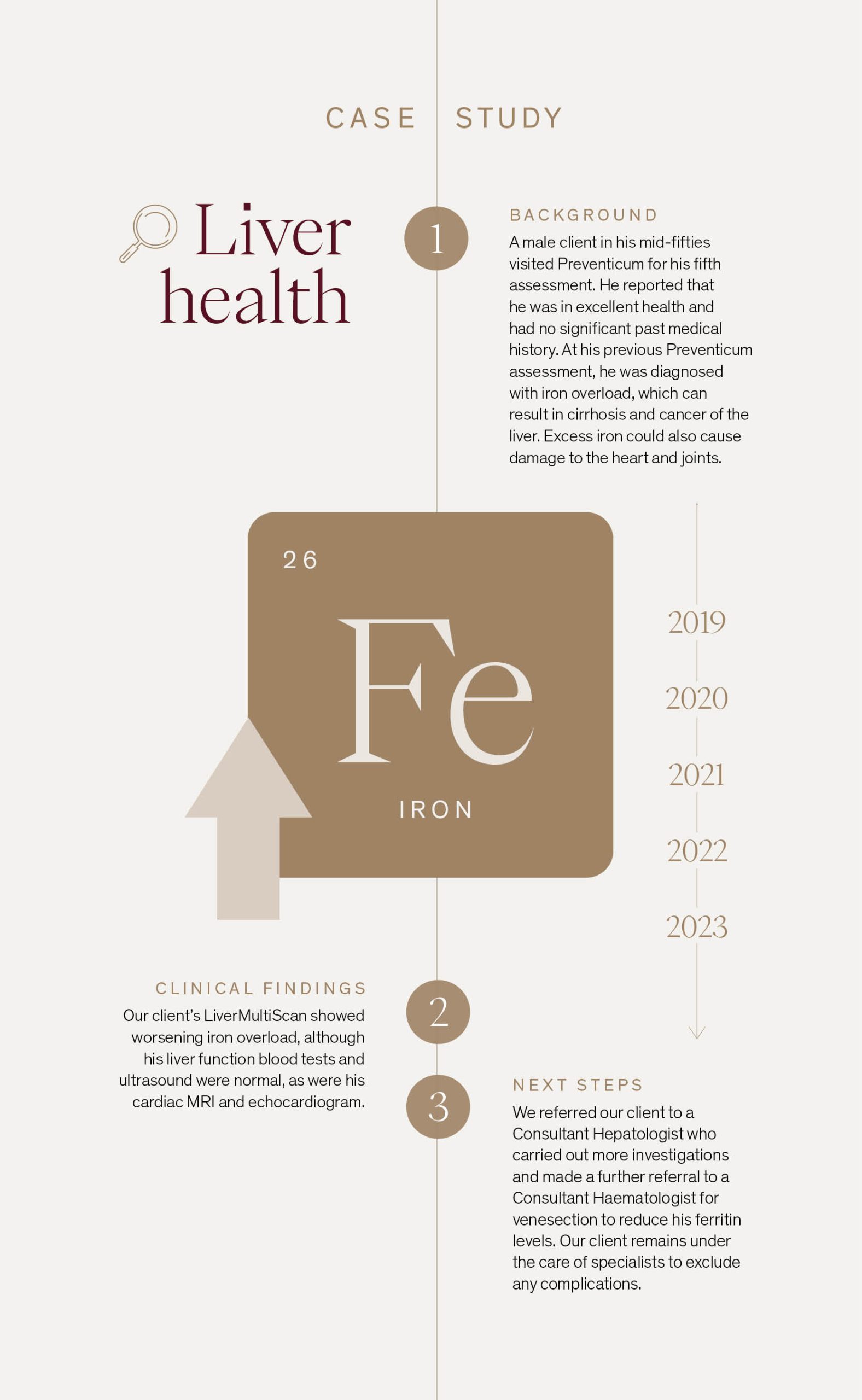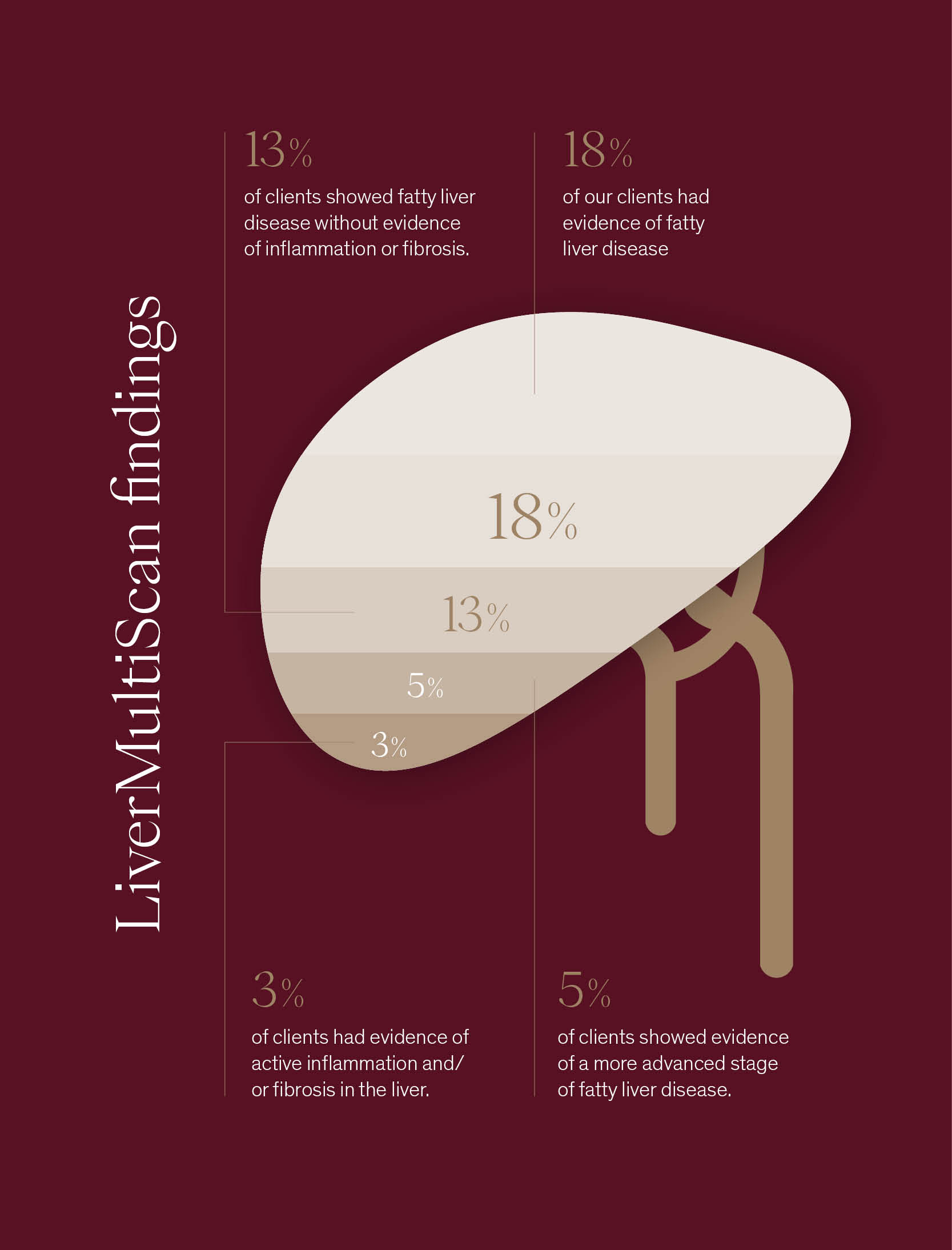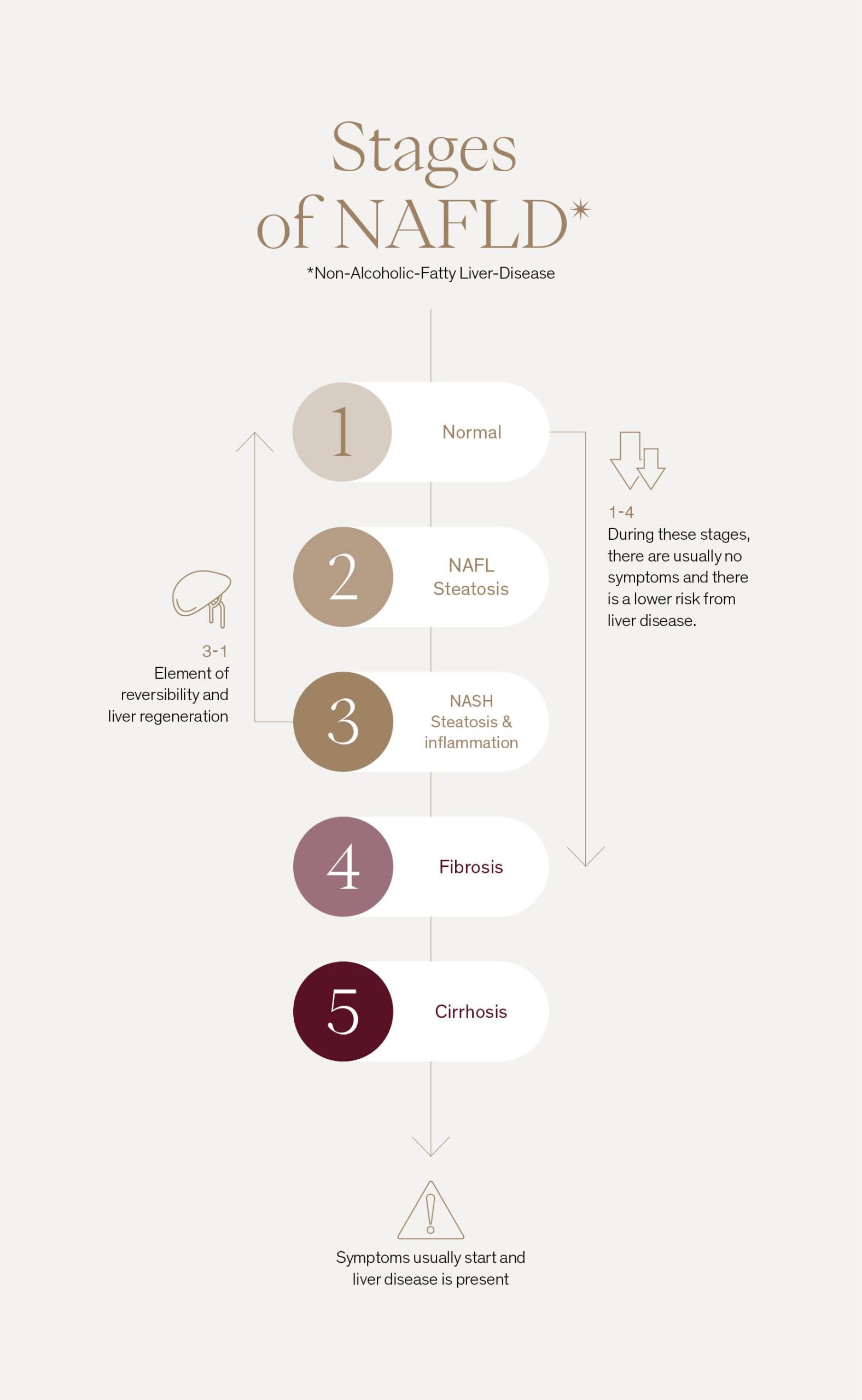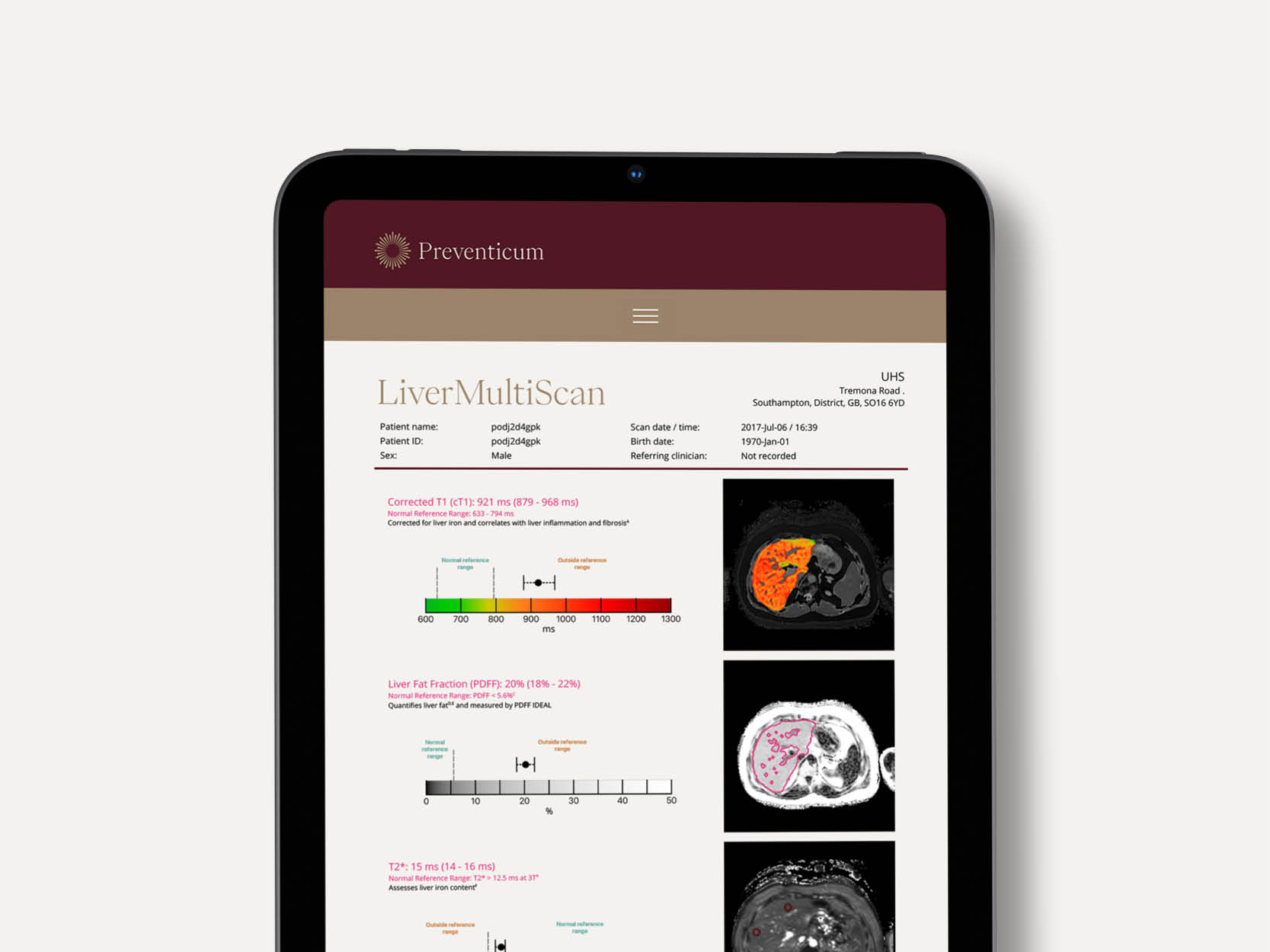Protecting Your Liver Health
It is estimated that 1 in every 3 people in the UK has early stages of NAFLD where there are small amounts of fat in their liver. *
The liver, our largest solid organ, performs over five hundred functions, including processing digested food from the intestine and converting this into energy, neutralising drugs and toxins and fighting infections in the body.
Often referred to as a ‘silent’ disease, non-alcoholic fatty liver disease (NAFLD) displays minimal symptoms in its early stages. Early diagnosis is crucial, as the liver has the ability to regenerate itself with lifestyle changes or medication before severe damage occurs.
At Preventicum, we evaluate your liver health using a combination of liver function blood tests, ultrasound and detailed consultations with your Preventicum Doctor. Our Optimal and Ultimate Assessments include LiverMultiScan, an advanced MRI scan providing detailed measures of inflammation, fibrosis, iron and fat in the liver.
What is NAFLD?
NAFLD is the most common cause of abnormal liver blood test results in the UK and it is estimated that one in every three people are in the early stages of NAFLD. Prevalence increases with age, particularly in males aged 40-65 years.
Characterised by the accumulation of fat in the liver, primarily in overweight or obese individuals, NAFLD is not caused by alcohol consumption, though excessive drinking can predispose one to developing it. While our livers possess remarkable regenerative abilities, excessive and repeated damage may lead to irreversible scarring, increasing the risk of conditions such as type 2 diabetes, cardiovascular disease, and extrahepatic cancers.
A recent Swedish study of over 12,000 participants with varying severities of NAFLD showed a significant increase in the risk of developing severe infections leading to hospitalisation compared to those without the condition.
In 2023, 18% of our clients had evidence of fatty liver disease. Early-stage NAFLD may not cause noticeable symptoms, but as the condition progresses, individuals may experience fatigue, abdominal discomfort, and other signs of liver dysfunction.
What are the stages of NAFLD?
Non-alcoholic fatty liver (steatosis)
- Fat accumulates in liver cells without inflammation or scarring
- Lifestyle changes can improve this stage
Non-alcoholic steatohepatitis (NASH)
- This is a more serious stage where there is inflammation in and around the fatty liver cells which can cause swelling and scarring of the liver. This is estimated to affect up to 5% of the UK population.
NASH with fibrosis
- Where persistent inflammation causes scar tissue around the liver and nearby blood vessels
- The liver is still able to function normally and this stage may be partially reversible
Cirrhosis
- This is usually the result of long-term, continuous damage to the liver
- Together with fibrosis, the liver has no more healthy cells to support normal functions
- Complete liver failure and liver cancer can occur
Who is at risk of NAFLD?
You are at increased risk if you:
- are obese or overweight, particularly with increased waist fat
- have type 2 diabetes, high blood pressure or hyperlipidaemia
- follow a poor diet and do little or no exercise
- you are a smoker
- have insulin resistance, polycystic ovaries or are over 50
However, NAFLD has been diagnosed in people without these risk factors, including young children.
Symptoms of NAFLD
In the early stages of non-alcoholic fatty liver disease, individuals may not experience noticeable symptoms because the fat accumulation in the liver itself does not cause direct damage. It is often diagnosed incidentally during tests and health assessments.
Symptoms including tiredness and discomfort in the liver area are not common in the early stages of NAFLD but may occur if the disease progresses to a more advanced stage, such as non-alcoholic steatohepatitis (NASH) or cirrhosis.
Regular health assessments are crucial for early detection and intervention, especially for individuals at risk, such as those who are overweight or have certain medical conditions such as diabetes or metabolic syndrome. By identifying NAFLD early, lifestyle modifications and appropriate medical management can be implemented to prevent or slow down disease progression and reduce the risk of complications.
Symptoms of Non-Alcoholic Steatohepatitis (NASH), fibrosis or cirrhosis
- a dull or aching pain in the top right of the abdomen (over the lower right side of the ribs)
- fatigue (extreme tiredness)
- unexplained weight loss
- yellowness of the eyes and skin (jaundice)
- bruising easily
- vomiting blood
- dark black, tarry faeces
- periods of confusion or poor memory
- itching skin
- swelling in the legs, ankles, feet or abdomen
Diagnosis
NAFLD is often diagnosed during routine blood tests called liver function tests (LFTs). At Preventicum we complete a thorough collection of liver function blood tests, a detailed ultrasound of the liver and MRI scans. Our advanced LiverMultiScan accurately assesses for early signs of liver disease and quantifies liver fat content. Trend analysis over multiple Preventicum assessments provides clear information about liver health and the responses to implemented lifestyle adaptations.
Once a diagnosis of NAFLD has been confirmed, you may be sent to a liver specialist (hepatologist) for disease staging and in some cases, you may also need a liver biopsy where a small sample of liver tissue is taken using a very fine needle for analysis in a laboratory.
Treatment
There is no specific treatment for NAFLD, but early identification is key to avoid progression and the associated risks of liver disease, cardiovascular disease, and cancer. There are many medications to manage the conditions associated with NAFLD such as high cholesterol and type 2 diabetes.
Prevention
Adopting a healthy lifestyle is the primary method of preventing and managing NAFLD. There is robust evidence that gradual weight loss through a healthy, balanced diet with increased exercise can reduce the amount of fat in the liver as well as helping with associated conditions such as high blood pressure, diabetes and cholesterol.
-
- Reduce your intake of sugary foods and drinks.
- Opt for wholegrain carbohydrates which are high in fibre and have a low glycaemic index. These are also associated with a 30% reduction in risk of heart disease, stroke and type 2 diabetes.
- Increase your consumption of vegetables and fruit.
- Reduce your consumption of saturated fat which lowers heart disease risk.
- Moderate and monitor your portion sizes.
- Exercise regularly and aim for a minimum of 150 minutes of moderately vigorous or 75 minutes of vigorous aerobic exercise every week.
- Smoking cessation: smoking can increase the severity of liver damage and cessation can help reduce your risk of problems such as heart attacks and strokes.
- Reduce your alcohol consumption. Although NAFLD is not caused by alcohol, drinking more than the recommended amount may make the condition worse as alcohol is processed by your liver.
References:
The British Liver Trust, Guide to NAFLD
NHS website
British Dietetic Association
NICE CKS guidelines of Non-Alcoholic Fatty Liver Disease
*NHS Inform








